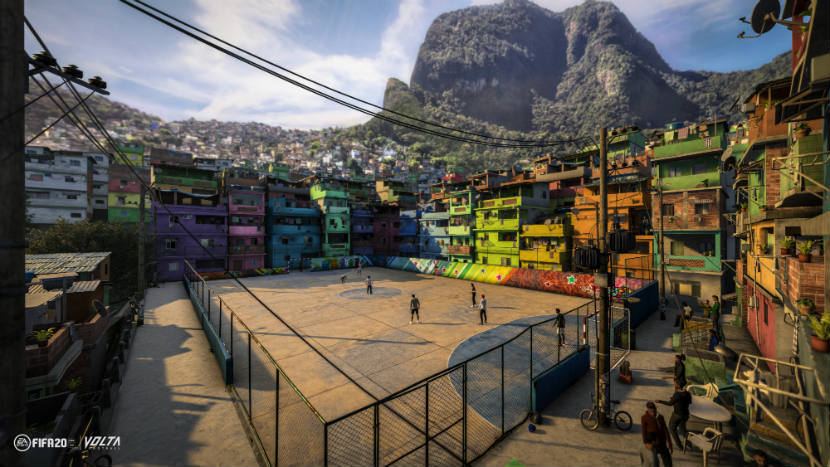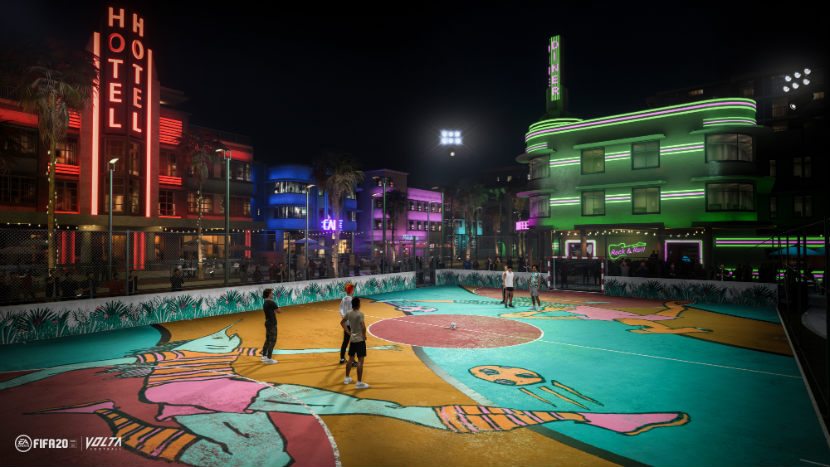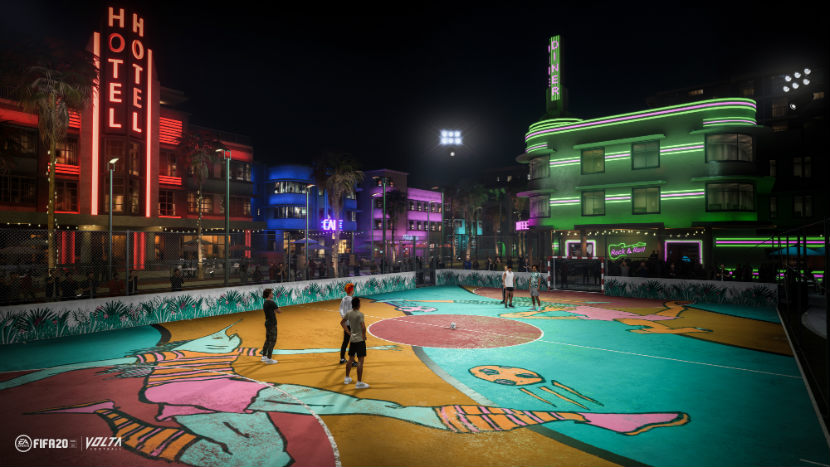For the past three summers, I’ve made a journey from Charlottesville, VA to San Francisco, specifically to play some EA Sports titles. For the past two years the event has been a multi-title showcase, but this year was all about FIFA 20. After surviving a bizarre encounter with the DEA, I sat in front of an early build of this year’s futbol fest, and got hands-on time with the new VOLTA mode, as well as more standard 11 v 11 play. VOLTA is getting the full red carpet treatment, and the team seems proud of its new baby. It’s a street-level mode, although there was plenty of emphasizing this isn’t FIFA Street. There’s a lot to love about VOLTA even from a sports-averse nerd such as myself, but at its core is a new gameplay philosophy that really pushes FIFA 20 to the next level.
The New FIFA Flow

Last year, when I attempted to play FIFA for the first time, I was instantly overwhelmed. The action was super fast, the AI was all over the place, and I could barely wrap my mind around the controls. As opposed to NHL or NBA Live, FIFA felt like it had the most imposing barrier of entry from a casual, non-fan standpoint. My journey in sports gaming is largely surface-level at best, but figuring out how my more traditional video game-addled brain adapts to sports sims has been a fascinating experience. To that end, FIFA was a tough nut to crack. I really bounced off it, especially in favor of NHL 19’s World of CHEL experience. But thanks to some major adjustments to FIFA’s fundamental play flow, I was immediately more comfortable, and able to understand what I was doing.
The FIFA gameplay team at EA seems to have almost entirely walked back its approach to a futbol sim, which was much more fast-paced and automated in years past. FIFA 20 is a drastically slower game, with much more passive action from the AI players. With the drop in speed comes a greater focus on what the human player behind the wheel is doing. More work has been done on the collision between two players, making one on one encounters a huge part of what FIFA 20 is. This makes the game, compared to my experience last year, feel more responsive and reactive, essentially more like a “real” video game. And enhancing this new, much more digestible and newbie-friendly vibe, is VOLTA.
It’s Street, but not That Street

VOLTA is a huge new mode, with all kinds of features such as online tournaments, direct competition with other teams, career mode-like single player paths, and a lot more. But aside from all the structural bells and whistles, VOLTA is about taking FIFA’s futbol off the field, and onto the streets, the makeshift play pitches, and specialized arenas. There are different kinds of geographical locations, with different physical properties that can significantly alter how you play. As stated in a pre-game demonstration, walls in VOLTA technically function as players, meaning you can kick the ball into one and that sucker will ricochet off like you’d expect it to in real life. This allows for some really wild maneuvers, trick shot setups, evasive passes, all sorts of stuff you’d never see on the normal field.
You also get to play with various team configurations in VOLTA. Some games I played went down to three on three, reminiscent of NHL’s Threes mode. This also meant no dedicated goalies in play, so FIFA began to resemble something like a mildly violent, multiplayer variant of Pong. I had most of my fun messing around with VOLTA games, replaying the same tournament over and over and steadily leveling up my crew. At the forefront of it all was of course my custom character, which is another big part of VOLTA.
Much like other EA Sports titles such as NBA Live, VOLTA wants you to build a “crew.” You start with your own custom player, along with a few premade starters. As you play, you can recruit members from your opponents’ teams, including other custom characters from online players. This feeds into the team’s goal of making VOLTA representative of the world around FIFA, with diversity of play and human presence being a key element. To that end, customization options are plentiful, you can pick your gender, and options like hair styles are universally applicable. If VOLTA pops off the way EA’s team wants it to, the end result will be colorful, community-driven, and relevant to the real world.
More Cards, Less Menus

I didn’t really get to play the Ultimate Team mode, although there was some presentational content describing what’s new for this year. The biggest takeaway is that the team is trying to streamline the “FUT” experience, making it so most of the menu options are based on drill-downs and broader sections, so that information is more digestible. There are also lots of wacky unlockables, such as different ball types and stuff like dabbing unicorn graphics in addition to the more serious, traditional stuff. If you’re down with the team building, customization, and card pack stuff, it looks like you’ll be right at home again this year, and possibly have a much easier time getting around.
Sometimes I feel like the simulation aspect of EA Sports’ suite of titles can overpower the actual video game part, especially when it comes to being able to digest visual information and feel like you’re in control of the game. With FIFA 20, I could immediately see and feel the difference despite not having played FIFA 19 since the last preview event. It’s a slower, more methodical game, with a greater emphasis on challenging individual players on the field and reacting to what’s happening in the moment instead of the bigger picture. Pushing that new core forward is VOLTA, a mode that will make fans looking for something fresh and engaging thrilled to sink their teeth into. Obviously there’s a ways to go before FIFA 20 drops on September 27, 2019. But I’m eager to dive into VOLTA and see where the community takes it.
FIFA 20 previewed at an event held by EA. Travel and accommodations were provided to the author.
This page contains affiliate links to products. Purchases made using these links help support PlayStation LifeStyle.





